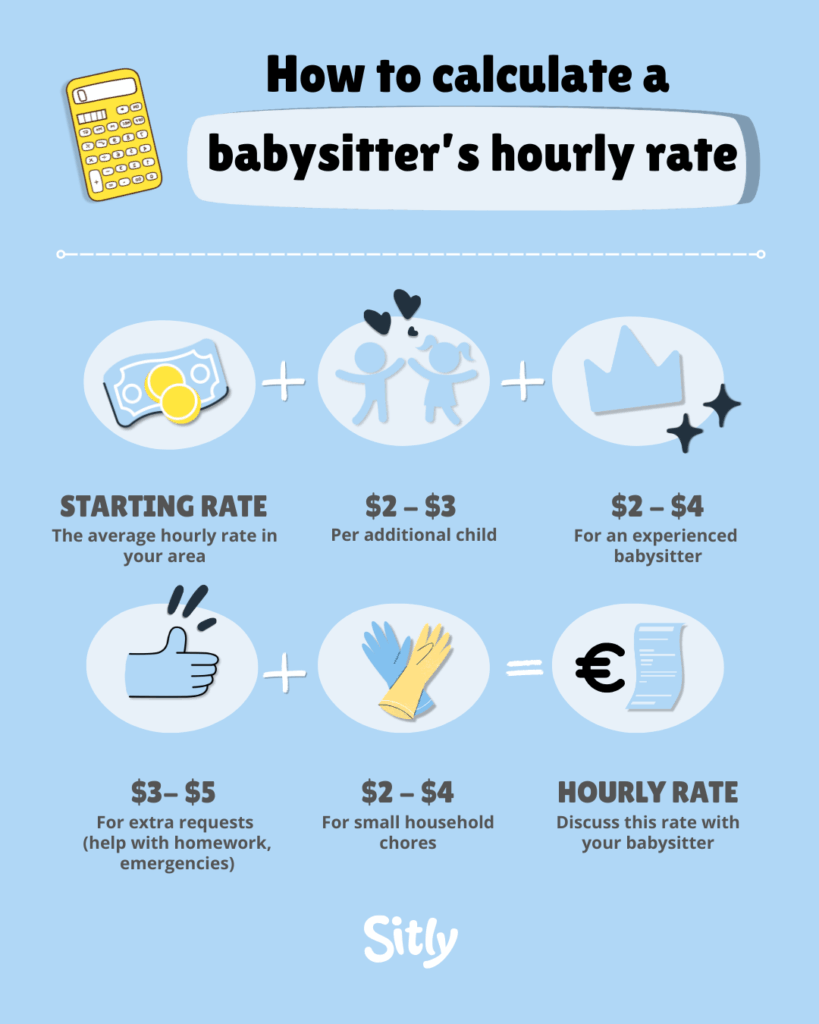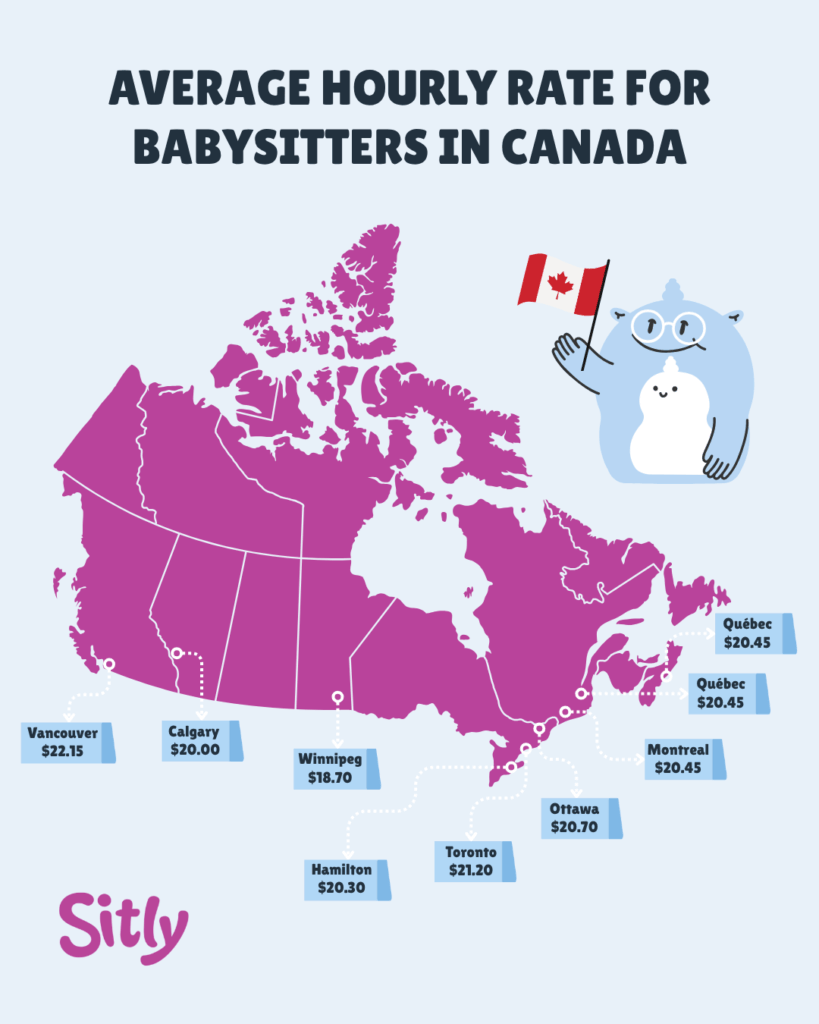How much does a babysitter cost? And what is a fair hourly rate for a babysitter? In this in-depth guide, you’ll find everything you need to know about babysitting costs in Canada, from teenage sitters to professional nannies. We’ll break down the average hourly rates, how much to pay based on age, experience, and location, and how extra tasks like cooking or caring for multiple children can impact the rate. You’ll also find real-life calculation examples, a table of minimum wages, and helpful tips to help you decide on a fair and responsible babysitter salary. Perfect for parents looking to balance affordability with high-quality, trustworthy childcare.
Wondering how much a babysitter costs in Canada in 2025? Whether you’re hiring a teenager for occasional evening care or a professional nanny, babysitting rates vary based on age, experience, and responsibilities. In this guide, you’ll find average hourly rates, real-life examples, and tips to help you set a fair and responsible babysitter salary.
According to recent data from Sitly the average hourly rate for babysitters in Canada in 2025 is around $18.35.This typically reflects informal childcare provided by teenagers or university students, especially during evenings and weekends.
However, babysitting rates in Canada vary significantly — ranging from under $15.00 to over $25.00 per hour — depending on several key factors like the babysitter’s age, their childcare experience, whether they have first aid certifications, the number and age of children, your location.This figures are based on Sitly’s internal research.
The Type of Babysitter You Hire Makes a Big Difference:
- A professional nanny (with qualifications, regular hours, or live-in arrangements) will typically charge $20 to $30+ per hour, or may receive a monthly salary.
- A 16-year-old high school student providing casual babysitting once or twice a week may ask for a lower rate — typically between $15 and $17 per hour, especially in smaller towns or suburban areas.
When setting a fair rate, it’s important to consider not just the time spent, but also the level of responsibility involved. Caring for infants or multiple children, handling bedtime routines, or preparing meals are all tasks that usually justify a higher rate.
Babysitter Rates and the Legal Minimum Wage in Canada
When setting a babysitter’s pay, it’s important to consider the legal minimum wage in your province or territory. In Canada, the minimum wage for domestic workers like babysitters are set at the provincial level, and not all provinces apply these protections. In the following provinces and territories, babysitters are covered by minimum wage laws, meaning their pay cannot legally fall below the local minimum:
Babysitting rates by Province in Canada
| Province/Territory | Minimum wage (per hour) | Effective date |
| Ontario | $17.60 | October 1, 2025 |
| British Columbia | $17.85 | June 1, 2025 |
| Alberta | $15.00 | In effect since 2018 |
| Manitoba (if >12h/week) | $16.00 | October 1, 2025 |
| Saskatchewan | $15.35 | October 1, 2025 |
| Nova Scotia | $16.50 | October 1, 2025 |
| Newfoundland & Labrador | $16.00 | April 1, 2025 |
| Prince Edward Island | $16.50 | October 1, 2025 |
| Yukon | $17.94 | April 1, 2025 |
These rates represent the legal minimum for domestic workers, including babysitters, in regular employment situations. However, actual rates paid are often higher depending on experience, location, and availability.
What about the other provinces? In some provinces and territories — such as Québec, New Brunswick, Nunavut, and Northwest Territories — babysitting is not always covered by employment standards legislation, especially when the role involves only casual or in-home child care without other domestic duties. This means that in those areas, there is no legal obligation to apply the provincial minimum wage to a babysitter, and compensation may be negotiated more freely between families and caregivers.
Hourly vs. Fixed Babysitting Rate: What’s Common?
Most babysitters are paid by the hour, especially when the care is occasional, flexible, or last-minute. It’s the fairest way to match compensation to time and effort.
However, in some situations — like a regular weekly shift or a quiet evening when the kids are already asleep — families and babysitters may agree on a fixed or flat rate instead.
What to Keep in Mind When You Decide on an Hourly or Fixed Babysitting Rate
- Hourly payments are best when schedules vary, duties may change, or you sometimes need help on short notice. You pay for every hour (or partial hour), ensuring your babysitter is fairly compensated — even when plans shift or extra tasks arise.
- Fixed or flat rates work well when the arrangement is predictable: for example, every Saturday night from 6 to 11 p.m., with no extra chores involved. It’s easier to budget and keeps things simple for both parties.
What to Keep in Mind if You Use a Fixed Babysitting Rate
- Always clarify what the fixed rate includes: number of children, whether light housework is expected, if travel or late-night hours are involved, etc.
- Make sure your flat rate doesn’t underpay the babysitter if the workload unexpectedly increases.
- Even with flat rates, many parents choose to add a bonus for extra duties — like staying later, helping with dinner, or managing a more demanding evening than usual.
Example: A babysitter agrees to a flat rate of $50 for a 5-hour evening (when the children are already in bed and no extra chores are required). If they arrive earlier, prepare meals, or stay later than planned, an hourly supplement may be appropriate to keep things fair.
How Experience and Qualifications Affect Babysitter Rates
A babysitter’s experience, training, and certifications significantly affect their expected rate— and justifiably so.
It’s not just about age:
- A 20-year-old student studying early childhood education, or holding CPR/First Aid certification, will typically charge $20–25/hour, depending on the region.
- Even a 15-year-old with consistent babysitting experience might ask for more than the minimum wage, and families often agree — especially if the sitter is reliable and trusted.
In general: the more skilled or qualified the babysitter, the higher their expected rate
It’s a personal decision. As a parent, you get to decide what feels right for your situation:
- Are you comfortable hiring someone who’s just getting started — and paying a bit less while they gain experience?
- Or do you prefer someone with professional background, and are willing to pay more for added peace of mind?
There’s no one-size-fits-all answer — just an agreement that works for both of you. If you’d like a guideline to help calculate fair babysitting wages in Canada, check the visual reference below.

What Tasks Does Your Babysitter Handle?
The hourly rate for a babysitter in Canada doesn’t just depend on their age or experience — it also depends on what you ask them to do during the job. If your babysitter is taking on extra responsibilities, it’s fair to reflect that in their pay.
Examples of tasks that may justify a higher rate:
- Caring for multiple children: Managing two or three kids at once is a lot more demanding than watching one child. Expect to pay more for this.
- Special care needs: If your child has medical conditions, behavioural challenges, or simply requires constant attention, a higher hourly rate is entirely appropriate.
Example: Babysitter (18 years old) – 3 Children + Dinner Prep
Sarah is 18 years old and has extensive babysitting experience. She recently started a teacher training program and holds a pediatric CPR certification.
Once a week, she works for a family with three kids aged 8, 5, and 3. She arrives at 3:00 PM, picks up the older children along with the toddler from school, and brings them all home for snacks and playtime. The parents also appreciate it when she prepares dinner, so they can eat together when they return around 5:30 PM.
What’s a Fair Rate for Sarah? Breakdown of her rate:
- $16.50/hour → Local minimum wage (Nova Scotia)
- +$3.00/hour → For managing two additional children
- +$1.50/hour → For experience and CPR certification
- = $21.00/hour
She works for 2.5 hours, so her pay is: $21.00 × 2.5 = $52.50
Because Sarah also cooks dinner, the family rounds it up to a flat $55.00 — a fair and simple rate for both sides.
Babysitting Babies vs. Older Kids
The age of your children plays an important role when deciding on a fair babysitting rate. Caring for a baby or toddler is hands-on, non-stop work. The sitter needs to be constantly attentive — feeding, changing, comforting, and engaging with the child. This level of care justifies a higher hourly rate.
With children aged six and up, things are usually simpler. They can eat on their own, use the bathroom independently, and often entertain themselves. This reduces the sitter’s workload, and the rate may reflect that.
In general: the younger and more dependent the child, the higher the level of responsibility — and the pay — should be.
Household Tasks and Light Cleaning
If you ask your babysitter to take on household chores in addition to caring for your children, it’s reasonable to increase the rate.
Tasks that may justify a higher babysitting rate include:
- Vacuuming common areas
- Loading or unloading the dishwasher
- Folding laundry
- Washing dishes
- Preparing dinner
Keep in mind: in Canada, a cleaner typically earns between $20 and $25 per hour. If your sitter is helping around the house, it’s absolutely fair to pay above the base babysitting rate to reflect the additional work.
Evening Babysitting vs. Daytime Babysitting
Do you only need someone for the evening, or is your sitter also handling the after-school routine?
Evening babysitting is often paid at a slightly lower rate, especially if:
- The children are already asleep
- There’s little active care involved (unless they wake up)
Daytime babysitting usually includes:
- Picking up children from school
- Preparing snacks or meals
- Supervising playtime
- Managing bath and bedtime routines
If your sitter is actively engaged from the afternoon through bedtime, it’s reasonable to offer a higher hourly rate.
Tip: Some parents choose to adjust the rate after 8:00 PM, when the children are usually asleep — or agree on an average flat rate that balances busy and quiet hours fairly.
Example Babysitter (16 years old) – 2 Children, Weekend Evenings
Lia is a 16-year-old high school student in Grade 11. She has over two years of babysitting experience, mostly with her younger brother and cousins. In her current babysitting family, she occasionally looks after two children on weekend evenings. When she arrives at 7:30 PM, the kids are already asleep. She stays until 11:30 PM, and the parents drive her home afterward. They also provide snacks and drinks and ask her to unload the dishwasher during the evening.
What’s a reasonable rate for Lia?
- $15.00/hour → Suggested rate for teen sitters with light duties
- +$1.00/hour → For supervising an additional child
= $16.00/hour
However, because the children are already asleep and there’s little active care involved, Lia and the parents agree on a flat rate of $15.00/hour.
Total pay: $15.00 × 4 hours = $60.00
Lia is very happy with this arrangement: it’s a quiet evening, she feels trusted, and the rate reflects the light responsibilities.
Last-Minute or On-Call Babysitters
Need a babysitter on short notice? That kind of flexibility often comes with a higher price. Spontaneous bookings — especially for morning care or during unexpected situations — may require the babysitter to cancel personal plans or rearrange their day. When this happens, it’s respectful to offer a slightly higher hourly rate. Last-minute availability is convenient for you, but it should be rewarded fairly.
Example Babysitter (21 years old) – 1 Child, After-School Care & Lunch Prep
Nina is 21 and currently studying Early Childhood Education. She holds a Child CPR certification and has a flexible class schedule this term. Every Wednesday afternoon, she babysits one child in a regular family. She picks up the 6-year-old boy from school at 12:00 PM, prepares lunch, plays with him, and stays until the parents return around 6:00 PM. The child is very active, so Nina stays engaged the whole time. The family provides all lunch supplies and reimburses small expenses like bus fare or extra snacks.
What’s a reasonable rate for Nina?
- $18.00/hour → Typical rate for qualified babysitters (based on Job Bank Canada)
- +$1.00/hour → For CPR certification and childcare qualifications
- +$1.00/hour → For active, high-energy care
= $20.00/hour
She works for 6 hours, so the total is:
$20.00 × 6 hours = $120.00. A fair and transparent agreement for both sides.
Talking About Pay With Your Babysitter
Once you’ve decided on a fair hourly rate, the next step is to discuss it openly with your babysitter. These conversations can sometimes feel a little awkward — especially if it’s your first time hiring a sitter — but being clear from the start helps avoid misunderstandings later on.
Tip: Ask your babysitter if they already have a rate in mind. Most sitters — especially teens and students — have a general expectation based on experience, age, or what their friends earn.
If you both come prepared with realistic expectations and can explain your reasoning, it’s much easier to agree on a rate that feels fair and sustainable for both sides. A respectful conversation builds trust — and makes it more likely that your babysitter will stay reliable, motivated, and happy in the long run.
Hourly Babysitting Rates by City in Canada
To help you understand what a fair rate might be for your babysitter, here are the average hourly rates reported by Sitly babysitters aged 16 to 21, based on their public profiles on the platform. These figures reflect the average rates that babysitters themselves request — not what families necessarily pay — and are a useful reference for setting expectations in your area.

Data based on the hourly rates set by babysitters registered on Sitly in Canada, from a database of over 96.000 profiles.
As the table shows, babysitting rates vary significantly across Canadian cities. Urban centres with higher living costs — like Vancouver and Toronto — naturally show the highest average rates, exceeding $21 per hour. These cities also tend to have greater demand for flexible, qualified babysitters, which can drive rates up.
On the other hand, cities like Winnipeg or Edmonton show slightly lower averages, closer to $18–19/hour, which still reflect fair compensation but align with lower overall cost of living in those regions. Interestingly, the rates in smaller cities like Halifax or Hamilton are quite competitive, often close to those in major metros. This may be due to local labour shortages, strong demand for childcare, or simply higher expectations from sitters.
Tip: When in doubt, ask around — other parents in your neighbourhood or school community can be a great resource to help you confirm what’s standard in your city.
Why Location Matters for Babysitter Pay
Babysitting rates can vary significantly by city, province, and even neighbourhood — and the main reason is simple: supply and demand. In areas where there are many babysitters available but fewer families actively hiring, rates tend to be lower, as sitters compete for fewer opportunities.
In contrast, in neighbourhoods where many families are looking for childcare but there aren’t enough babysitters to meet demand, rates naturally increase. This is especially true in urban centres, or in communities with young families and limited after-school care options.
When deciding what to pay, it’s always a good idea to ask around in your local area. Talk to friends, neighbours, or other parents at school or daycare. Knowing what others are paying gives you a realistic benchmark and helps ensure that your offer is fair — both for the sitter and for your budget.
What Does a Nanny Cost in Canada?
If you need regular daytime childcare and prefer a consistent caregiver who works in your home, hiring a nanny might be the right solution. In Canada, a nanny usually provides part-time or full-time care, either as a live-in or live-out arrangement. This role is quite different from that of an occasional babysitter, both in terms of responsibilities and cost.
A babysitter typically looks after children on an occasional basis — for example, during evenings or weekends — and handles basic supervision like playtime, bedtime routines, or simply being present while the children sleep. Babysitters are usually younger, may not have formal training, and are often paid by the hour.
A nanny, on the other hand, offers a more structured, ongoing arrangement. She may be responsible for preparing meals, taking children to and from school or activities, helping with homework, organizing daily routines, and even doing light household tasks. Many nannies have formal training in early childhood education, First Aid or CPR certification, and several years of experience. Because of this, the hourly rate for a nanny is generally higher.
What does a nanny vs a babysitter cost in Canada? In terms of pay, babysitters in Canada typically earn CA$15 to CA$20 per hour, while nannies can earn anywhere from $20 to $30 or more, depending on their experience, location, and the nature of their duties. Live-in nannies might have a slightly lower hourly rate, but families are expected to provide room and board, which balances the total cost.
So, What Should You Pay a Babysitter in Canada?
There’s no universal answer when it comes to babysitting rates — and that’s because every situation is different. The right amount to pay depends on a mix of factors, including:
- The babysitter’s age, experience, and any certifications (like First Aid or CPR)
- The number of children and their ages
- Whether extra tasks are involved, such as preparing meals, helping with homework, or light cleaning
- Whether the care takes place during the day, in the evening, or involves overnight stays
- Your location — rates in big cities like Toronto or Vancouver are often higher than in smaller towns
- And of course, your personal budget
In the end, it’s about finding the right balance between fair compensation and reliable, affordable care for your family. The most important ingredient? Clear communication. Talk openly with your babysitter about what you expect and what you’re able to offer. When both sides are on the same page, it’s easier to agree on a rate that feels fair and sustainable.
Table of contents


FAQS

In 2025, most parents in Canada pay between $16 and $22 per hour for a babysitter. Rates vary depending on your location, the sitter’s experience, and the number of children. In big cities like Toronto, Vancouver, and Ottawa, babysitters often charge closer to $20–$25 per hour, while smaller towns or rural areas may see rates around $15–$18. If your babysitter has first aid certification, childcare training, or many years of experience, expect to pay at the higher end.
The average babysitting rate in Canada is around $18 per hour, according to Sitly’s data. However, the national average hides big regional differences — for example, Vancouver and Toronto often have the highest rates, while cities like Winnipeg or Halifax are slightly lower. Many families also adjust pay based on the sitter’s age, reliability, and duties (like bedtime routines, meal prep, or homework help). For occasional babysitting, parents typically pay hourly; for regular weekly help, some negotiate a flat rate.
Yes, most babysitters increase their rate when caring for more than one child. The typical increase is $1–$3 extra per hour per additional child, depending on their ages and needs. For instance, managing a baby and a toddler at the same time often requires more attention than watching two older kids. Some babysitters set a flat hourly rate that covers up to two children, and then add a small supplement for each extra one. Discussing expectations early — including mealtimes, bedtime, and any special routines — helps avoid misunderstandings and ensures fair pay for the workload.
Overnight babysitting rates in Canada depend on how many active hours are required. Many parents pay a flat fee between $80 and $150 per night, or an hourly rate until bedtime (usually $18–$22/hour) plus a reduced hourly rate for sleeping hours. If the sitter needs to wake up to feed a baby or attend to young children during the night, it’s fair to increase the total amount. Providing meals, a comfortable sleeping space, and transportation is also standard. For regular overnight care — such as when parents work night shifts — a negotiated weekly rate can be more practical.
Babysitter rates in Toronto and Vancouver average $22–$27 per hour, among the highest in the country. The higher cost of living and strong demand for reliable childcare increase rates, particularly for sitters with CPR certification or childcare experience.


Trusted sitters, right around the corner
Need a little help? Sitly connects you with experienced babysitters in your area. Whether you need occasional or regular care, finding the right babysitter is super easy. Browse profiles, read reviews, and reach out to your favorites right away.






 Services
Services